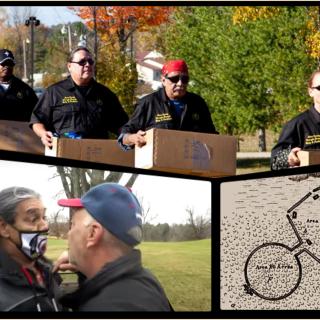Advertisement
On an overcast but otherwise pleasant Saturday morning in late September, about 300 volunteers set out on a litter sweep of the Kokosing River. By the time the mud they stirred up had settled, the volunteers had collected more than six tons of trash. That included nearly two tons of tires — 171 of them.
These folks don’t mess around.
Not that I expected they would. Earlier in September, some of the volunteers — The Kokosing River Rats — helped with the Friends of the Mohican River Watershed cleanup, covering the river from Greer to Brinkhaven. In short, they kicked ass, digging out tires and heavy debris from what is considered one of the most scenic stretches of the Mohican.
On Sept. 21, it was time to return the favor. Representing the Mohican Watershed group, I headed down to Millwood on the Kokosing with my friend, Elaine, and my Grumman canoe. I wanted to help and get down and dirty with these folks on the Kokosing, but I had an ulterior motive. Our Mohican crew is a relatively new group, having only two cleanups under our belts. I wanted to see how a well-established group conducted a river sweep.
The entire cleanup covered nearly 30 miles of stream, from Mount Vernon to Riley Chapel Road plus a section of Delano Run. Volunteers came from all walks of life, including high school and college students, probationers, and families with young children. The effort was coordinated by state and local government agencies — including the Ohio Environmental Protection Agency and Knox County Solid Waste District, businesses and civic and recreational organizations. It would be easier to list who HADN’T contributed to this enormous effort.
The Kokosing River Rats, sponsor of Paddle for Heroes, coordinated our group. We spent eight hours covering the river from the town of Millwood to Riley Chapel Road.
It was an impressive flotilla – canoes, kayaks and even a paddleboard. The latter would serve as a “trailer,” which would be used to tow a huge truck tire downstream to the first litter drop-off. Yes, first. Arrangements had been made to dump the first collection of trash at one site and the rest at the takeout point off Riley Chapel Road.
The concept of using kayaks on litter sweeps was foreign to me. But, soon after we hit the river, the advantage became clear. They were more maneuverable than canoes and could get into tighter spots to get at litter. If debris was too big to fit on the kayaks — and some folks got quite a bit on their tiny boats — it could be stacked on or in canoes. No one minded taking more of the load. If anything, they were eager to see how much they could carry on their canoes in the shallow river.
Volunteers welcomed challenge after challenge of digging tires, construction debris and even road signs mounted on a heavy wooden post out of smelly mud, sand and gravel. The catch of the day was a scuttled 17-foot Pelican canoe. The guy who found it, mounted the badly damaged hull atop several tires he already had collected in his canoe.
According to Randy Canterbury, director of Knox County Recycling and Litter Prevention, this year’s haul represented a 39.38 percent increase over the tonnage collected in the 2018 sweep and a nearly nine percent increase in the number of tires.
Which left organizers asking, why the big jump? Did this year’s heavy rains churn up more trash and tires from the riverbed? Are people pitching more tires into the river? Are homeless people along the river contributing to the problem? (On the Mohican, we attribute a lot of our trash to tourism.)
Of course, the big question should be why do we have to do river sweeps in the first place? It should NEVER be acceptable to throw trash or allow trash to get into our streams. But, the reality is, it does. And it will. But there’s a silver lining; river sweeps like this bring out the best in humanity.


